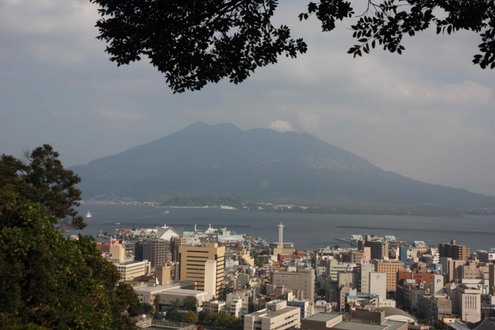Back at Kagoshima-chuo I was satisfied with the day's activities, and would have been quite happy to have headed back to the hotel, but Madam was determined to get a couple of scenic shots across the bay to Sakurajima, so we headed off on one of the two bus services that offer a scenic loop around the city.
I suppose we could, had the mood taken us, have got on and off at several of the sites around the circuit, the first of which commemorated St Francis Xavier, but there wasn't much of interest on the way around once we'd dismissed Senganen Garden (also known as Isoteien) as a possibility.
We’d passed this particular landscape garden as a possibility when we passed it on the train as we headed along the coast just north of Kagoshima. We were probably doing ourselves out of a major spectacle since the garden’s most striking feature is its use of Sakurajima and Kagoshima Bay as borrowed scenery, but by this point on the trip we were in scenic sensory overload.

In any case, if you’re passing, it’s worth noting Senganen dates back to1658 and owes its existence to the Shimazu clan, who ruled the Satsuma domain until the end of the feudal age and were early adopters of Western science and technology, as evidenced by the long stone building that stands just outside the main garden area. It was one of the earliest Western style factories in the country and now houses a museum with exhibits about the Shimizu and the early stages of Japan's nineteenth century modernization.
No, as far as Madam was concerned Shiroyama Observatory at the summit of the 107-metre Mount Shiroyama would do us very nicely, thank you. The mountain was once the site of a castle and Shiroyama literally means castle mountain. The castle's ruins at the base of the mountain are now the site of the Reimeikan Museum and were one of the stops we skipped on the way up to the Observatory.
Shiroyama Observatory is (probably rightly) famed for spectacular views across downtown Kagoshima, Kagoshima Bay and Sakurajima and, in fine weather with good visibility, as far as the Kirishima Mountains, but the haze that had been a nuisance in the distance all day really made its presence felt even at this moderately low altitude, and there wasn't a great deal of joy for the photographic fraternity.
The park surrounding the Observatory is also of interest to students of Japanese history, since it was the site of the last battle in 1877's Satsuma Rebellion and local hero Saigo Takamori supposedly made his last stand at Saigo's Cave, another site we passed by on the way up.
A couple of bus services take you around the sights of Kagoshima, so we could have got to a number of them, but opted to head back to the hotel. This travel bit can tend to become wearing.
Dinner that night was in a French establishment on the other side of the main road from the previous night’s pork emporium, and rather impressive it was. That’ll have to do as far as the narrative is concerned because Hughesy, for some reason, missed completing this particular bit of the travelogue in a timely manner, and now, close to a month later the details have vanished from the memory.